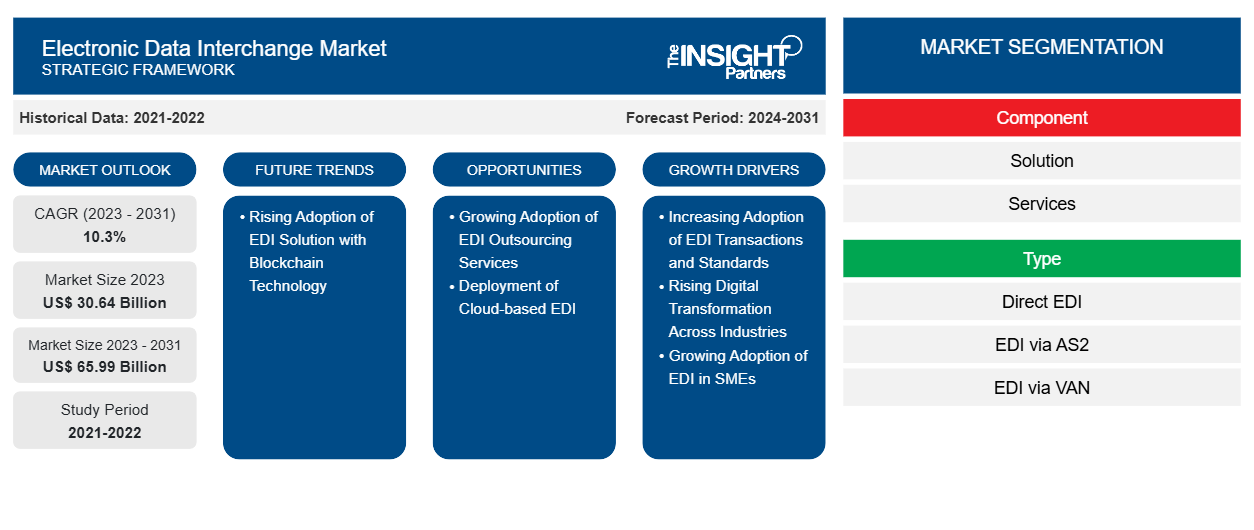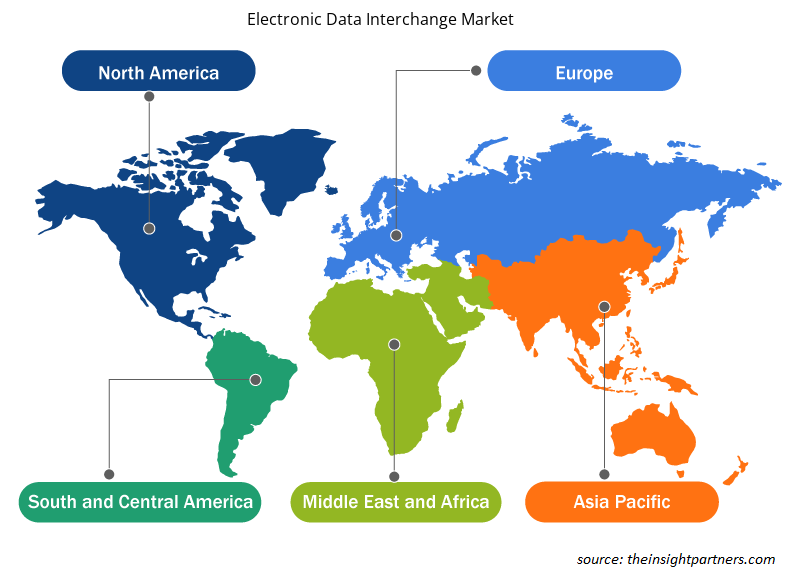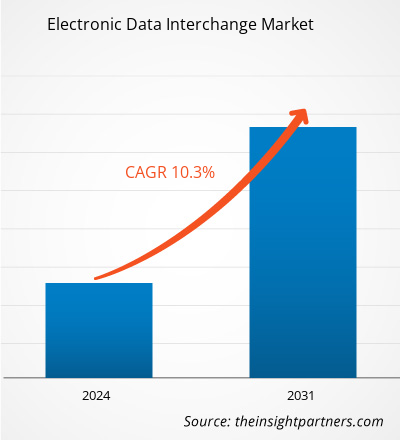من المتوقع أن يصل حجم سوق تبادل البيانات الإلكتروني إلى 74.36 مليار دولار أمريكي بحلول عام 2031، مقارنةً بـ 34.02 مليار دولار أمريكي في عام 2024. ومن المتوقع أن يسجل السوق معدل نمو سنوي مركب قدره 11.9% خلال الفترة 2025-2031. ومن المرجح أن يُحدث دمج حلول تبادل البيانات الإلكتروني (EDI) مع تقنية البلوك تشين اتجاهات جديدة في السوق خلال السنوات القادمة.
تحليل سوق تبادل البيانات الإلكترونية
تتطلب حلول تبادل البيانات الإلكترونية (EDI) صيانة دورية، إذ يعتمد عليها سير العمل العام للمؤسسة. وترى العديد من المؤسسات أن تبادل البيانات الإلكترونية (EDI) يلتزم بالعديد من اللوائح والمعايير. وهذا يعيق الشركات الصغيرة من التعامل مع المؤسسات الكبيرة لنشر نسخة محدثة من معايير المستندات. وتتبادل المؤسسات مستندات تبادل البيانات الإلكترونية مباشرةً مع عملائها أو تستعين بمزودي خدمات خارجيين. ومع التوجه المتزايد نحو رقمنة مستندات الأعمال لضمان كفاءة المعالجة، تم تطبيق العديد من اللوائح والمعايير، مما يعزز التحول من الفواتير الورقية إلى الفواتير الإلكترونية عالميًا.
يُعدّ التحوّل الرقمي المتزايد وقبول حلول تبادل البيانات الإلكترونية (EDI) في اتجاهات معاملات البيانات في قطاعات الخدمات المصرفية والمالية والتأمين (BFSI) وتجارة التجزئة والتصنيع، إلى جانب متطلبات الامتثال المتزايدة المتعلقة بتبادل البيانات الإلكترونية (EDI) والمبادرات الحكومية المواتية لتعزيز اعتماد حلول تبادل البيانات الإلكترونية (EDI)، من العوامل الحاسمة التي تدفع الطلب على حلول تبادل البيانات الإلكترونية (EDI) عالميًا. ومع ذلك، فإنّ عيب تبادل البيانات الإلكترونية (EDI) يتمثل في ارتفاع تكلفة التنفيذ، بالإضافة إلى الوقت الذي يستغرقه نشر الحلول. على الرغم من هذه القيود، من المتوقع أن يُسهم التبني المتزايد لمعاملات تبادل البيانات الإلكترونية (EDI) ومعاييره، والتحول الرقمي المتزايد في مختلف القطاعات، في تعزيز نمو السوق خلال فترة التوقعات.
نظرة عامة على سوق تبادل البيانات الإلكترونية
تبادل البيانات الإلكترونية (EDI) هو عملية آلية تُمكّن الشركات من تبادل مستندات إلكترونية، مثل الفواتير، وأوامر الشراء، وإشعارات الشحن المسبقة، والجمارك، والدفعات، والمخزون، وسندات الشحن، ووثائق حالة الشحن. يُمكّن تبادل البيانات الإلكترونية المؤسسات من تنظيم تبادل البيانات بين تطبيقات سلسلة التوريد، كما يضمن إرسال البيانات المهمة للأعمال في الوقت المحدد. وقد استبدل تبادل البيانات الإلكترونية (EDI) التواصل التجاري التقليدي بإعداد البريد ومعالجته، مما يُمكّن المؤسسات من تحسين أداء سير العمل بشكل عام. كما أن المعالجة السريعة والدقيقة لمستندات تبادل البيانات الإلكترونية (EDI) تُقلل من تكرار العمل، بالإضافة إلى تقليل الطلبات الملغاة ونفاد المخزون.
ستحصل على تخصيص لأي تقرير - مجانًا - بما في ذلك أجزاء من هذا التقرير، أو تحليل على مستوى الدولة، وحزمة بيانات Excel، بالإضافة إلى الاستفادة من العروض والخصومات الرائعة للشركات الناشئة والجامعات
سوق تبادل البيانات الإلكترونية: رؤى استراتيجية

-
احصل على أهم اتجاهات السوق الرئيسية لهذا التقرير.ستتضمن هذه العينة المجانية تحليل البيانات، بدءًا من اتجاهات السوق وحتى التقديرات والتوقعات.
محركات وفرص سوق تبادل البيانات الإلكترونية
تزايد اعتماد تبادل البيانات الإلكترونية في الشركات الصغيرة والمتوسطة
يُستخدم تبادل البيانات الإلكترونية (EDI) بانتظام بين الشركات الصغيرة والمتوسطة. ونظرًا لقلة مواردها البشرية، يُساعدها تبادل البيانات الإلكترونية (EDI) على أتمتة عملياتها بدلًا من الاعتماد على الطرق التقليدية. فهو يُمكّن من مشاركة مجموعة متنوعة من المستندات والبيانات وفقًا لقواعد ومعايير تبادل البيانات الإلكترونية (EDI) العالمية والإقليمية لعملية التبادل الإلكتروني بأكملها. ويشمل ذلك النقل، وتدفق الرسائل، وتنسيق المستندات، والبرامج المستخدمة لإرسال واستقبال المستندات في الشركات الصغيرة والمتوسطة. ويؤدي نمو الشركات الصغيرة والمتوسطة عالميًا إلى زيادة عدد المعاملات الآلية، مما يُعزز الطلب على حلول تبادل البيانات الإلكترونية (EDI) بين هذه الشركات. فعلى سبيل المثال، ووفقًا لبيانات المفوضية الأوروبية لشهر يوليو 2024، شهدت أوروبا ارتفاعًا بنسبة 5.4% في عدد الشركات الصغيرة والمتوسطة، مع زيادة في معدل التوظيف بنسبة 4.8%. بلغ إجمالي نمو الشركات الصغيرة والمتوسطة في المنطقة 4.5% بين عامي 2021 و2023. ويزيد هذا النمو من عدد الأنشطة التجارية ويزيد الطلب على حلول تبادل البيانات الإلكترونية (EDI) لتبسيط العمليات، وتحسين الكفاءة التشغيلية، وتقليل النفقات العامة لتكنولوجيا المعلومات. تتيح حلول تبادل البيانات الإلكترونية (EDI) للشركات الصغيرة والمتوسطة تبادل المستندات الرئيسية، مثل أوامر الشراء والفواتير، بسلاسة إلكترونيًا، متجنبةً بذلك الإجراءات اليدوية والأوراق الورقية. ويؤدي ذلك إلى معالجة أسرع للطلبات، وتقليل الأخطاء، وتحسين إدارة المخزون ، مما يُحسّن الأداء العام للأعمال.
علاوة على ذلك، يشجع تزايد الرقمنة والطلب المتزايد على الحلول الآلية الشركات الصغيرة والمتوسطة على اعتماد الحلول السحابية. تعمل الحلول السحابية على أتمتة العديد من جوانب عملية تبادل البيانات الإلكترونية (EDI) - مثل التحقق من الصحة، وتعيين البيانات، وترجمة التنسيقات، وتبسيط سير العمل، وتقليل الإدخال اليدوي للبيانات. ووفقًا لاستطلاع Public First الذي أُجري عام 2024، اتفق 85% من الشركات الصغيرة والمتوسطة التي تستخدم الخدمات السحابية التي شملها الاستطلاع على أن استخدام الخدمات السحابية سهّل عليها المنافسة مع الشركات الأكبر حجمًا. يمكن أن يؤدي الاعتماد المتزايد على حلول تبادل البيانات الإلكترونية (EDI) إلى زيادة توليد الإيرادات لمقدمي خدمات تبادل البيانات الإلكترونية (EDI). ونتيجة لذلك، يجعل مقدمو الخدمات حلول تبادل البيانات الإلكترونية (EDI) أكثر تكلفة وسهولة في الوصول إليها لتوسيع أعمالهم. علاوة على ذلك، تمكن الشركات الصغيرة والمتوسطة التي تستثمر في تبادل البيانات الإلكترونية (EDI) من التجارة مع المؤسسات الأكبر حجمًا مع معالجة المزيد من المعاملات التجارية في الوقت نفسه. وبشكل عام، يساعد تبادل البيانات الإلكترونية (EDI) الشركات الصغيرة والمتوسطة على العمل بكفاءة أكبر مع السماح لها بمعالجة المزيد من المعاملات وإجراء الأعمال مع المؤسسات الأكبر حجمًا. وبالتالي، فإن الاعتماد المتزايد على تبادل البيانات الإلكترونية (EDI) بين الشركات الصغيرة والمتوسطة يعزز نمو سوق تبادل البيانات الإلكترونية .
الطلب المتزايد على خدمات الاستعانة بمصادر خارجية لتبادل البيانات إلكترونيًا
يتم الاستعانة بمصادر خارجية لبرنامج تبادل البيانات الإلكترونية (EDI) عبر خدمات مُدارة، وذلك من خلال إدارة منصة تبادل بيانات إلكترونية (EDI) وتنفيذها لصالح مُزود خارجي. عادةً ما يُقدم مُزود الاستعانة بمصادر خارجية حلولاً أو خدمات سحابية تُمكّن الشركات من تبادل المستندات بأمان، مثل أوامر الشراء والفواتير وإشعارات الشحن. يتطلب الاستعانة بمصادر خارجية من المؤسسات الوصول إلى مجموعة واسعة من الإمكانيات والاستثمارات الرأسمالية للأجهزة والبرامج. تُركز العديد من الشركات بنشاط على دمج تبادل البيانات الإلكترونية (EDI) مع أنظمة المكاتب الخلفية، بما في ذلك نظام تخطيط موارد المؤسسات (ERP) الذي يُساعد الشركات على تلبية الطلب على الموارد الداخلية. علاوة على ذلك، أصبح اعتماد نهج الخدمات المُدارة لتبادل البيانات الإلكترونية (EDI) شائعًا بين المؤسسات نظرًا لفوائده الكبيرة، مثل:
- تدعم خدمات EDI المُدارة المستندة إلى السحابة الشركات في التنسيق مع الشركاء التجاريين للتحقق من صحة تدفق البيانات وإجراء اختبارات EDI الشاملة
- توفير تحديثات داخلية تلقائية وفقًا للتغييرات في متطلبات الشركاء التجاريين
- دعم المراقبة الداخلية وتحسين معاملات EDI ومبادرات الصيانة
- دعم على مدار الساعة طوال أيام الأسبوع من شركاء التداول والأنظمة وقنوات المبيعات وخبراء خدمات EDI
- يوفر مراقبة مستمرة لتقليل إدخال البيانات ومنع الأخطاء
يُعدّ تطبيق خدمات EDI الخارجية أكثر جاذبيةً من خدمات التعهيد في مجالات أخرى من صناعة تكنولوجيا المعلومات. ويهدف هذا التطبيق إلى خفض تكلفة البنية التحتية، وضمان تبادل دقيق للبيانات وفي الوقت المناسب، وتعزيز التكيف السريع مع التغيرات في متطلبات الشركاء التجاريين، وضمان الحصول على المهارات المناسبة لتقديم الخدمات للعميل. يوفر تطبيق EDI الخارجية مزايا متعددة، مثل توفير الوصول إلى أحدث التقنيات، والتواصل مع الأنظمة الخارجية، وتوفير خدمات ذات قيمة مضافة تُمكّن المستخدم من التداول في جميع أنحاء العالم. كما يُعزز EDI مرونة الأعمال من خلال تمكين المستخدمين من دخول أسواق جديدة بسرعة، وزيادة إنتاجيتها من خلال توفير معلومات متقدمة تتعلق بالأداء، وسلسلة التوريد، وشركاء الأعمال. لذلك، من المتوقع أن يُتيح الطلب المتزايد على خدمات EDI الخارجية فرصةً لنمو سوق تبادل البيانات الإلكترونية خلال فترة التوقعات.
تحليل تجزئة تقرير سوق تبادل البيانات الإلكترونية
إن القطاعات الرئيسية التي ساهمت في استخلاص تحليل سوق تبادل البيانات الإلكترونية هي المكون والنوع والصناعة.
- بناءً على مكونات السوق، يُقسّم السوق إلى حلول وخدمات. وسيُهيمن قطاع الحلول على السوق في عام ٢٠٢٤.
- من حيث النوع، يُصنف السوق إلى تبادل إلكتروني مباشر (EDI)، وتبادل إلكتروني عبر AS2، وتبادل إلكتروني عبر VAN، وتبادل إلكتروني عبر الهاتف المحمول، وتبادل إلكتروني عبر الويب، والاستعانة بمصادر خارجية لتبادل الإلكتروني، وغيرها. وقد هيمن قطاع تبادل الإلكتروني عبر VAN على السوق في عام 2024.
- بحسب القطاع، يُصنَّف سوق تبادل البيانات الإلكتروني إلى قطاعات الخدمات المصرفية والمالية والتأمينية، والرعاية الصحية، وتجارة التجزئة والسلع الاستهلاكية، وتكنولوجيا المعلومات والاتصالات، والنقل والخدمات اللوجستية، والسيارات، والأغذية والمشروبات، وغيرها. وقد هيمن قطاع تجارة التجزئة والسلع الاستهلاكية على السوق في عام 2024.
تحليل حصة سوق تبادل البيانات الإلكترونية حسب المنطقة الجغرافية
يُقسّم سوق تبادل البيانات الإلكتروني إلى خمس مناطق رئيسية: أمريكا الشمالية، وأوروبا، وآسيا والمحيط الهادئ، والشرق الأوسط وأفريقيا، وأمريكا الجنوبية. وقد هيمنت أمريكا الشمالية على السوق في عام 2024.
تستضيف أمريكا الشمالية العديد من شركات التكنولوجيا العملاقة التي تستثمر بكثافة في تطوير تقنيات فعّالة. ومع الارتفاع المستمر في معاملات البيانات بين الشركات (B2C) والشركات (B2B)، من المتوقع أن تشهد العديد من المؤسسات وشركائها نموًا في أعمالها مستقبلًا. وتُبدي العديد من المؤسسات اهتمامًا بحلول تبادل البيانات الإلكترونية (EDI) لتبادل بياناتها بدقة وكفاءة وأمان. يوجد في الولايات المتحدة العديد من مزودي الخدمات الذين يقدمون حلول تبادل البيانات الإلكترونية (EDI) المؤتمتة. وقد أدى اعتماد حلول تبادل البيانات الإلكترونية (EDI) إلى زيادة الكفاءة وتوفير التكاليف في مختلف المؤسسات التابعة للحكومة الأمريكية. علاوة على ذلك، يشهد تطبيق تبادل البيانات الإلكترونية (EDI) نموًا تدريجيًا في المنطقة بفضل التقنيات الناشئة واستثمارات المؤسسات في الأنظمة السحابية.
رؤى إقليمية حول سوق تبادل البيانات الإلكترونية
قام محللو إنسايت بارتنرز بشرح شامل للاتجاهات والعوامل الإقليمية المؤثرة في سوق تبادل البيانات الإلكتروني خلال فترة التوقعات. ويناقش هذا القسم أيضًا قطاعات سوق تبادل البيانات الإلكتروني ونطاقه الجغرافي في أمريكا الشمالية، وأوروبا، وآسيا والمحيط الهادئ، والشرق الأوسط وأفريقيا، وأمريكا الجنوبية والوسطى.

- احصل على البيانات الإقليمية المحددة لسوق تبادل البيانات الإلكترونية
نطاق تقرير سوق تبادل البيانات الإلكترونية
| سمة التقرير | تفاصيل |
|---|---|
| حجم السوق في عام 2024 | 34.02 مليار دولار أمريكي |
| حجم السوق بحلول عام 2031 | 74.36 مليار دولار أمريكي |
| معدل النمو السنوي المركب العالمي (2025 - 2031) | 11.9% |
| البيانات التاريخية | 2021-2023 |
| فترة التنبؤ | 2025-2031 |
| القطاعات المغطاة |
حسب المكون
|
| المناطق والدول المغطاة |
أمريكا الشمالية
|
| قادة السوق وملفات تعريف الشركات الرئيسية |
|
كثافة اللاعبين في سوق تبادل البيانات الإلكترونية: فهم تأثيرها على ديناميكيات الأعمال
يشهد سوق تبادل البيانات الإلكتروني نموًا سريعًا، مدفوعًا بتزايد طلب المستخدم النهائي نتيجةً لعوامل مثل تطور تفضيلات المستهلكين، والتقدم التكنولوجي، وزيادة الوعي بمزايا المنتج. ومع تزايد الطلب، تعمل الشركات على توسيع عروضها، والابتكار لتلبية احتياجات المستهلكين، والاستفادة من الاتجاهات الناشئة، مما يعزز نمو السوق.
تشير كثافة اللاعبين في السوق إلى توزيع الشركات أو المؤسسات العاملة في سوق أو قطاع معين. وتشير إلى عدد المنافسين (اللاعبين في السوق) الموجودين في سوق معين نسبةً إلى حجمه أو قيمته السوقية الإجمالية.
الشركات الرئيسية العاملة في سوق تبادل البيانات الإلكترونية هي:
- شركة Salesforce, Inc. (MuleSoft)
- شركة SPS للتجارة
- شركة ترو كوميرس
- شركة آي بي إم
- كليو
- مجموعة جينيريكس
إخلاء المسؤولية : الشركات المذكورة أعلاه ليست مرتبة بأي ترتيب معين.

- احصل على نظرة عامة على أهم اللاعبين الرئيسيين في سوق تبادل البيانات الإلكترونية
أخبار سوق تبادل البيانات الإلكترونية والتطورات الأخيرة
يُقيّم سوق تبادل البيانات الإلكتروني بجمع بيانات نوعية وكمية بعد البحث الأولي والثانوي، والتي تشمل منشورات الشركات المهمة، وبيانات الجمعيات، وقواعد البيانات. فيما يلي بعض التطورات في سوق تبادل البيانات الإلكتروني:
- أعلنت كليو عن شراكة مع Programmers.io، الشركة الرائدة في توفير حلول تمكين الذكاء الاصطناعي والتكنولوجيا للشركات في قطاعات التصنيع والنقل والتأمين وتجارة التجزئة. تجمع هذه الشراكة الاستراتيجية بين قوة منصة Cleo Integration Cloud (CIC) والخبرة التقنية العميقة لـ Programmers.io. ستوفر الشركتان معًا تكاملات EDI وواجهات برمجة التطبيقات (API) مصممة خصيصًا لتتناسب بسلاسة مع عمليات الأعمال مع تزايد احتياجات العملاء.
(المصدر: شركة ليبرتي ميوتشوال للتأمين، بيان صحفي، مارس 2025)
- تُمكّن خدمة تبادل البيانات بين الشركات (AWS B2B Data Interchange) من إنشاء شيفرة ربط لتبادل البيانات الإلكتروني (EDI) باستخدام الذكاء الاصطناعي التوليدي. تُسرّع هذه الإمكانية الجديدة عملية كتابة واختبار ربطات تبادل البيانات الإلكتروني ثنائية الاتجاه، مما يُقلل الوقت والجهد والتكاليف المرتبطة بنقل أحمال عمل تبادل البيانات الإلكتروني إلى AWS. تُعد خدمة تبادل البيانات بين الشركات (AWS B2B Data Interchange) خدمة مُدارة بالكامل تُؤتمت تحويل معاملات تبادل البيانات الإلكتروني (EDI) المهمة للأعمال على نطاق واسع، مع مرونة في التسعير وإمكانية الدفع حسب الاستخدام.
(المصدر: Liberty Mutual Surety، بيان صحفي، نوفمبر 2024)
تغطية تقرير سوق تبادل البيانات الإلكتروني والمنتجات النهائية
يقدم تقرير "حجم سوق تبادل البيانات الإلكتروني وتوقعاته (2021-2031)" تحليلاً مفصلاً للسوق يغطي المجالات المذكورة أدناه:
- حجم سوق تبادل البيانات الإلكترونية وتوقعاته على المستويات العالمية والإقليمية والوطنية لجميع قطاعات السوق الرئيسية التي يغطيها النطاق
- اتجاهات سوق تبادل البيانات الإلكترونية، بالإضافة إلى ديناميكيات السوق مثل المحركات والقيود والفرص الرئيسية
- تحليل مفصل لـ PEST و SWOT
- تحليل سوق تبادل البيانات الإلكترونية الذي يغطي اتجاهات السوق الرئيسية والإطار العالمي والإقليمي والجهات الفاعلة الرئيسية واللوائح والتطورات الأخيرة في السوق
- تحليل المشهد الصناعي والمنافسة الذي يغطي تركيز السوق، وتحليل خريطة الحرارة، واللاعبين البارزين، والتطورات الأخيرة لسوق تبادل البيانات الإلكترونية
- ملفات تعريف الشركة التفصيلية
- التحليل التاريخي (سنتان)، سنة الأساس، التوقعات (7 سنوات) مع معدل النمو السنوي المركب
- تحليل PEST و SWOT
- حجم السوق والقيمة / الحجم - عالمي، إقليمي، بلد
- الصناعة والمنافسة
- مجموعة بيانات إكسل
التقارير الحديثة
تقارير ذات صلة
شهادات العملاء
سبب الشراء
- اتخاذ قرارات مدروسة
- فهم ديناميكيات السوق
- تحليل المنافسة
- رؤى العملاء
- توقعات السوق
- تخفيف المخاطر
- التخطيط الاستراتيجي
- مبررات الاستثمار
- تحديد الأسواق الناشئة
- تحسين استراتيجيات التسويق
- تعزيز الكفاءة التشغيلية
- مواكبة التوجهات التنظيمية






















 احصل على عينة مجانية ل - سوق تبادل البيانات الإلكترونية
احصل على عينة مجانية ل - سوق تبادل البيانات الإلكترونية